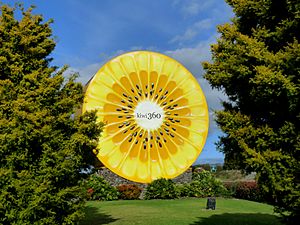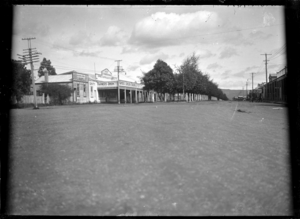Te Puke facts for kids
Quick facts for kids
Te Puke
|
|
|---|---|

The giant kiwifruit in Te Puke
|
|
| Country | New Zealand |
| Region | Bay of Plenty |
| Territorial authority | Western Bay of Plenty District |
| Ward | Maketu-Te Puke |
| Community | Te Puke Community |
| Settled | pre-European |
| Founded | 1880 |
| Electorates |
|
| Area | |
| • Total | 12.13 km2 (4.68 sq mi) |
| Population
(June 2023)
|
|
| • Total | 10,250 |
| • Density | 845.0/km2 (2,188.6/sq mi) |
| Time zone | UTC+12 (NZST) |
| • Summer (DST) | UTC+13 (NZDT) |
| Postcode |
3119
|
| Area code(s) | 07 |
Te Puke is a town in New Zealand. It is located about 18 kilometers southeast of Tauranga. Te Puke is famous for growing Kiwifruit.
The town is near coastal places like Tauranga and Maketu. It is also close to smaller towns such as Waitangi and Paengaroa. A new highway, the Tauranga Eastern Link, opened in 2015. This road helped reduce traffic in Te Puke.
The name "Te Puke" comes from the Māori language. It means "the hill". The town is built on a hill near the Papamoa Hills. You should say it "teh-pook-ee".
Contents
Discover Te Puke's People
Te Puke covers an area of about 12.13 square kilometers. In 2018, its population was around 8,688 people. This means there were about 716 people living in each square kilometer.
The town's population has been growing. From 2006 to 2018, the number of people living in Te Puke increased by about 24.8%.
Who Lives in Te Puke?
In 2018, there were 2,793 homes in Te Puke. There were slightly more males than females. About 20.8% of the people were under 15 years old. Around 18.1% were 65 or older.
Te Puke is a diverse place. The main ethnic groups are:
About 24.6% of the people in Te Puke were born overseas. This is a bit less than the national average for New Zealand.
Beliefs and Work in Te Puke
Many people in Te Puke do not have a religious belief (42.2%). Others are Christian (30.9%). Some follow Māori religious beliefs (3.4%) or Hindu (2.6%).
About 48.9% of people aged 15 and over work full-time. Another 14.9% work part-time.
Te Puke's Rich History and Culture
Te Puke has a long and interesting history. It was settled long before Europeans arrived.
Early Māori Settlement
Around the year 1350, the Te Arawa canoe landed at Maketu. This canoe sailed from Hawaiki. Chief Tama-te-kapua was in charge. He gave many places in the area their original names. Māori people explored the rivers and built many pā (fortified villages) in the area.
European Arrivals
In 1769, Captain James Cook sailed near Te Puke. He was the first European to visit this area. He named it the Bay of Plenty because it looked fertile and had many people.
In 1830, a Danish sailor named Philip Tapsell settled in Maketu. He worked as a trader. Missionaries from the Church Missionary Society (CMS) arrived soon after. They set up mission stations in nearby areas.
First European Settlers
After the land wars in the 1860s, more European settlers came to the Bay of Plenty. In 1876, surveying of the Te Puke Block began. This was land for new settlers.
The first settlers arrived in Te Puke in 1879. More settlers came from London in 1881 on a ship called the Lady Jocelyn.
Te Puke's Growth and Development
The town of Te Puke grew steadily over the years.
Building Roads and Trade
In July 1880, work started on the road from Tauranga to Te Puke. This road was built by police and local Māori. Before this, people used an old Māori trail over the Papamoa Hills.
Goods and people could also travel by boat from Tauranga. They would go to Maketu, then up the Kaituna River. From there, Māori canoes would take them up the Waiari Stream.
Early Businesses and Industries
By late 1881, Te Puke had 25 wooden buildings. These included two hotels, stores, a butcher, and a post office. Settlers quickly started farming. By 1884, they had a butter factory. They grew crops like maize and wheat.
Later, some farmland was "bush sick." This meant the soil lacked certain minerals. Farmers fixed this in the 1930s by using cobalt.
Other industries also grew. Flax milling was big until the 1940s. Saw milling started in 1905 and is still important today. Gold was found in the Papamoa Hills in 1883. A gold mine operated there in the 1920s.
When the railway was built, a large quarry opened in Te Puke. This provided many jobs. A meat processing plant opened in 1968. A research center for horticulture, HortResearch, opened in 1971.
The Tarawera Eruption
On June 10, 1886, Mount Tarawera erupted. Te Puke residents woke up to loud noises and earthquakes. Ash and mud covered crops and pastures up to 12 inches deep. The sun was hidden until the afternoon.
Many farm animals starved. Farmers had to let their animals go free. People in Te Puke also ran short of food and water. Help came from Tauranga. You can still find signs of the Tarawera eruption in the ground today. Te Puke was also covered in ash during the 1995 Mount Ruapehu eruption, but not as much.
Te Puke town grew. A mission/town hall was built in 1883. The first school, Te Puke Primary, opened in 1883. The local newspaper, The Te Puke Times, started in 1912. The fire brigade and town boards were formed in 1913.
Many clubs started in Te Puke. These included a jockey club (1890), a brass band (1903), and a rugby union (1906). Trees were planted down the main street between 1914 and 1918. This was a memorial to soldiers who died in the war.
The Railway Arrives
The East Coast Main Trunk Railway passes through Te Puke. It opened in 1928. Passenger trains, like the Taneatua Express, used to run between Auckland and Taneatua. From 1959 to 1967, a special railcar service ran only as far as Te Puke. This service stopped because of mechanical problems and not enough passengers.
Growing Fruit in Te Puke
Te Puke's climate and soil are perfect for growing fruit. This is called horticulture.
- Early Fruits: In the 1880s, tobacco was grown, but this stopped in the 1930s. People also tried growing hops, rice, and grapes. Farmers found that apples, pears, oranges, and lemons grew very well. The first commercial fruit orchard in Te Puke was planted in 1915.
- Post-War Orchards: After World War Two, many soldiers returning from war became orchardists in Te Puke. By 1960, most of No 3 Road was covered in orchards.
- The Rise of Kiwifruit: In 1934, Jim MacLoughlin bought a lemon and passionfruit orchard. His neighbor, Vic Bayliss, had two Chinese gooseberry plants. Jim was inspired and planted half an acre of Chinese gooseberries in 1937. During World War II, American soldiers in New Zealand tried Chinese gooseberries and loved them. This led to more plantings. In 1952, the first Chinese gooseberries were exported. In 1959, the fruit was renamed "Kiwifruit."
Today, the Hayward (green) kiwifruit is very popular. In 1998, "Zespri Gold" kiwifruit was introduced. Scientists are still working on new types, like a peelable kiwifruit and "kiwiberry."
Marae in Te Puke
There are five marae (traditional Māori meeting places) in Te Puke. Each marae is connected to local iwi (tribes) and hapū (sub-tribes).
- Haraki Marae: Connected to Waitaha and Ngāti Rangiwewehi.
- Makahae – Te Kahika Marae: Connected to Tapuika's Ngāti Tuheke. In 2020, the government helped upgrade this marae and others.
- Manoeka Marae: Connected to Waitaha.
- Moko – Ngāti Moko Marae: Connected to Tapuika's Ngāti Moko.
- Tawakepito Marae: Connected to Tapuika's Ngāti Tuheke.
Te Puke's Economy
Farming is the most important part of Te Puke's economy. The warm, wet weather and rich soil are great for growing plants.
Kiwifruit Capital
Te Puke is known as the "Kiwifruit capital of the world." Besides kiwifruit, farmers also grow avocados and citrus fruit like lemons and oranges. Dairy cattle and other animals are also farmed here.
Today, Te Puke is a busy town. It has a main shopping street called Jellicoe Street. There are many schools, churches, and clubs in the town.
During April and May, many people work picking or packing kiwifruit. This includes people from other nearby towns. The number of workers can go over 10,000 during the harvest season.
Education in Te Puke
Te Puke has several schools for different age groups.
- Te Puke High School: This is the high school for students in Year 9 to 13. It has about 1,230 students.
- Fairhaven School: A primary school for Year 1 to 6 students. It has about 170 students.
- Te Puke Primary School: Another primary school for Year 1 to 6 students. It has about 200 students.
- Te Puke Intermediate: This school is for Year 7 to 8 students. It has about 200 students.
- Te Kura Kaupapa o Te Matai: This is a Māori language immersion primary school for Year 1 to 8 students. It has about 100 students.
Te Puke's Climate
| Climate data for Te Puke (1991–2020) | |||||||||||||
|---|---|---|---|---|---|---|---|---|---|---|---|---|---|
| Month | Jan | Feb | Mar | Apr | May | Jun | Jul | Aug | Sep | Oct | Nov | Dec | Year |
| Mean daily maximum °C (°F) | 24.0 (75.2) |
24.1 (75.4) |
22.6 (72.7) |
20.2 (68.4) |
17.6 (63.7) |
15.1 (59.2) |
14.4 (57.9) |
15.3 (59.5) |
16.8 (62.2) |
18.5 (65.3) |
20.3 (68.5) |
22.2 (72.0) |
19.3 (66.7) |
| Daily mean °C (°F) | 18.8 (65.8) |
19.1 (66.4) |
17.4 (63.3) |
15.1 (59.2) |
12.7 (54.9) |
10.4 (50.7) |
9.8 (49.6) |
10.4 (50.7) |
12.0 (53.6) |
13.6 (56.5) |
15.2 (59.4) |
17.4 (63.3) |
14.3 (57.8) |
| Mean daily minimum °C (°F) | 13.6 (56.5) |
14.1 (57.4) |
12.2 (54.0) |
10.0 (50.0) |
7.8 (46.0) |
5.6 (42.1) |
5.2 (41.4) |
5.5 (41.9) |
7.2 (45.0) |
8.7 (47.7) |
10.0 (50.0) |
12.6 (54.7) |
9.4 (48.9) |
| Average rainfall mm (inches) | 96.6 (3.80) |
119.3 (4.70) |
128.8 (5.07) |
173.0 (6.81) |
148.9 (5.86) |
174.8 (6.88) |
168.0 (6.61) |
156.4 (6.16) |
130.6 (5.14) |
118.7 (4.67) |
93.0 (3.66) |
136.2 (5.36) |
1,644.3 (64.72) |
| Source: NIWA | |||||||||||||
See also
 In Spanish: Te Puke para niños
In Spanish: Te Puke para niños


